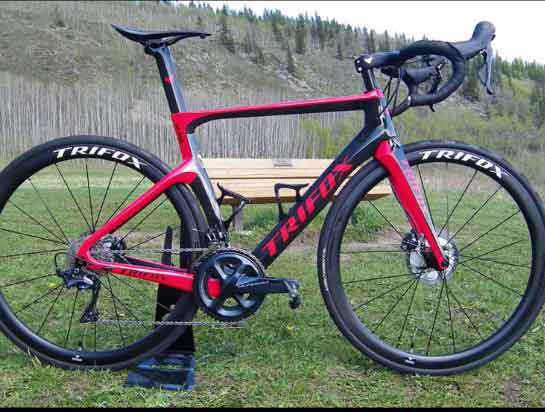
So far, the lifespan of the bicycle frame is impossible to consider. If it is well protected, it is not impossible to go back to the mountain cave. For metal frames, it is a hooligan to talk about the life of pipes without welding. Welding should be the most important issue for long-term riding of metal frames. There are two factors that affect welding quality. One is the quality control of manufacturers, and regular manufacturers must be extremely There is a high probability of showing good quality, and the other is the welder. After all, automatic welding is not so popular. Before your pipe is fatigued enough, there is a high probability that your solder joints are completely dead. Carbon fiber is really difficult to discuss. There are too many manufacturers with manufacturing capabilities, which directly improve the quality of carbon fiber, such as trifox brand, and carbon road bike frames for sale. Speaking of life, one impact may end the life, and carbon fiber frames often cannot spend a lifetime carefully. To sum up, no one can give an exact answer for the above material frames. Assuming that the welding situation is stable and the riding is not bumped, the titanium alloy will be voted for, and the dimensionality reduction blow from aerospace metal is also the only promise that can be made. Bike rack with a lifetime warranty. One more thing to add, the aging of the frame is often accompanied by abnormal noise, and a certain position will definitely be the first to attack, pay attention to listening, so as not to stumble.
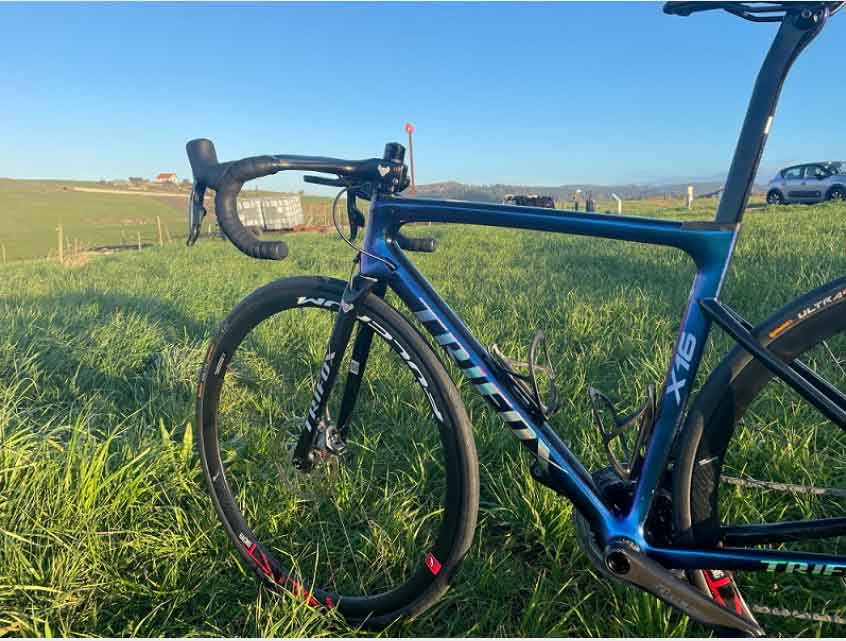
Some people prefer the full carbon fork, while others prefer the full rigid fork.Generally speaking, carbon fiber is lighter and more comfortable than steel.In this blog, I will explain everything you need to know about the tapered fork. The carbon mtb fork can mount on a steel frame.The main consideration is that the carbon fiber fork‘s steerer tube fits the 29 rigid fork.The 29 fork trims may be too short for some frames. Almost everyone who tries a 29er carbon fork reports that it is more comfortable than a bike fork.The reason is that carbon rigid fork is not as rigid as steel, absorbing more vibrations and minor shocks. However, the mountain bike fork is just a small part of the bike, so today I’m going to cover if bike forks make a difference.Why do road bikes have mtb rigid fork, is the cycle fork stronger, and is the boost fork reliable? Mountain Bike Carbon Fork on Steel Frame Would a non tapered fork make a difference?There are several potential carbon bike fork combinations on the bike.For example, you can use a rigid bike fork with a steel fork, a rigid mtb fork 29, or an mtb fork with a carbon fork.So, here’s an explanation of whether 29er rigid forks make a difference and whether they’re worth it.br /> Overall, the 29er fork does make a difference.In general, they are more comfortable than other types of rigid forks.However, for some types of bikes, it doesn’t make sense to use a carbon fork due to the nature of the ride type. Best Tapered Carbon Fork Material Carbon mtb fork has many other benefits over steel forks.The 29 fork is stronger, they make the bike faster and more comfortable.Also for downhill and mountain biking, the most comfortable carbon fiber forks are the 29 rigid fork and the 29er carbon fork.This really makes for a smoother ride than a road bike without any suspension at all. Carbon Rigid Fork Generally has Better Power Transfer and is More Responsive A bike fork on the bike provides more power transfer.However, many say that steel is much more comfortable than carbon.After independent testing of the mountain bike fork, it was found that with bicycle forks.The road bike is slightly more comfortable. Mtb Rigid Fork on Bike A cycle fork is the recommended type of boost fork for many bikes, including road and mountain. The build of the bike is often more important than the material Making a mountain bike rigid fork is a craft.A non-tapered fork from the same brand feels completely different than a carbon bike fork from another brand. Although they cost about the same and are made from the same rigid bike fork.In my opinion, the difference is more down to the rigid mtb fork 29 of the bike.So to decide if the mtb fork is better on steel, it’s important to look at quantifiable metrics about the 29er rigid fork. Why Does The Steel Frame have a 29er Fork? The steel frame uses a rigid fork instead of aluminum or steel.Steel frames have carbon forks because tapered forks are stronger, lighter, and more responsive than other types of metal.Not all steel frames have a carbon mtb fork and vary by make and model.The 29 fork can also easily replace.Many people report that the 29 rigid fork is more comfortable than the carbon fiber fork or frames made from other types of metal. Can You Easily Replace The 29er Carbon Fork on Your Bike? Loosening all the parts need for the carbon rigid fork of the bike is a very simple process.However, there are a lot of things that need to be loosened or removed before the bike fork can pull out and put in the new mountain bike fork.This might be a good idea if you are currently riding bikes with bike forks, mtb rigid forks, cycle forks, or boost forks and want to try mountain bike rigid forks to see how they feel. Why Do Road Bikes Have a Non Tapered Fork? The carbon bike fork is available in several different metals.Many of them also use rigid bike forks specifically, not other types of metal for rigid mtb fork 29, which is why mountain bikes use mtb forks.The 29er fork on the 29er rigid fork is more responsive, which gives them better acceleration and steering precision. A rigid fork is significantly better for someone who has ridden many different bikes and has a lot of riding experience.With all these points in mind, the carbon fork is stronger, lighter, and more responsive, and comfort is questionable.All of these aspects are good for road bikes, which is why a tapered fork is used. Is Carbon Mtb Fork Solid? Carbon fiber is a relatively new material used in bike parts like frames and 29 forks.Carbon is much lighter than the carbon fiber fork used to make.The carbon fiber bike 29 rigid fork is solid.The 29er carbon fork is also stronger than the steel and titanium forks.This means that the carbon rigid fork is actually the strongest of all the materials used to make the bike fork.These properties of a mountain bike fork mean it is 10 times stronger than a steel frame. Are Bicycle Forks Reliable? The mtb rigid fork is the main part of the bike and if it fails, it can cause a serious crash.Therefore, it is important to know which cycle forks are the most reliable and last the longest.Here’s an explanation of whether the boost fork is reliable:mountain bike rigid fork is the most reliable non tapered fork material.As an added bonus, they are also lighter and handle better than other types of carbon bike forks.Since rigid bike forks have higher strength, they will suffer less wear and tear. Please be free to click TRIFOX.
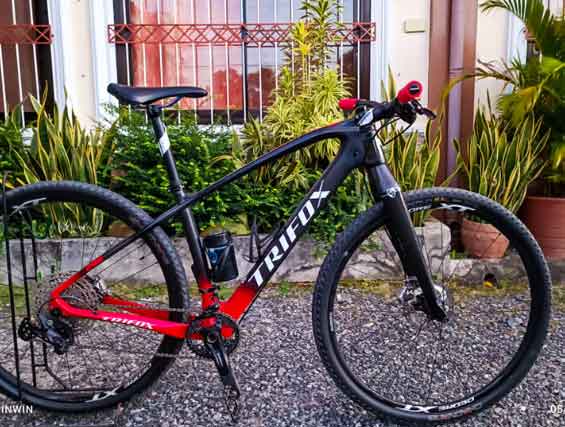
Hello everyone, welcome to the new issue of trifox cycling. Common materials for Bike Frame are generally carbon fiber, aluminum alloy, titanium alloy, steel or a mixture of these materials (such as the titanium alloy joint + carbon fiber tube frame mentioned in the previous article). These different materials will have different properties and will affect the cost, comfort, weight, strength, rigidity, durability and more of the frame. However, while materials are important, I would like to reiterate the importance of frame design and manufacturing process. Those mentioned above are the most common materials we see (although there are no bicycles made of wood, bamboo, etc.) If you’re starting with frame materials and planning to pick a bike, here are some things to consider: Weight: Each material has different strength properties, fatigue curves and impact resistance. When you choose, you have to make a trade-off, weight is only one aspect of it, if you are sensitive to weight and looking for performance, then lightweight materials are your first choice. However, if your goal is to be strong and durable. Can carry you and your dreams to walk all over the country, then weight should obviously not be your primary criterion. The function of the bike: This is a topic that every rider can’t avoid, don’t get carried away, think carefully about whether you need it or not before deciding whether it is necessary to buy it or not. If your bike is for racing, a rigid, lightweight bike is ideal and narrows down your material choices for you. Conversely, if you’re planning a long ride or traverse, and you’re going to be in the car for a long time and carry a lot of luggage, durability will be a priority. Again, this narrows down the options for you.carbon fibre bicycle Where you ride: While your location doesn’t affect your choice of frame material, framesets,consider things like steel frames that can rust when exposed to humidity for long periods of time. Therefore, at this time, the aluminum frame will be more suitable for those wet areas, and at the same time, it can provide characteristics close to the steel frame. Will it be your lifelong companion: All materials will fatigue over time, but some will come a little faster than others. Steel frames can rust if you’re not careful, but they’re also more durable than aluminum frames in the long run. Carbon fiber and titanium alloy frames are extremely resistant to fatigue, so they are also the most durable. Budget: Everything mentioned above needs to be established within your budget, which is also the biggest factor affecting what car we buy. For mainstream brands, titanium alloy frames are undoubtedly the most expensive, followed by carbon fiber frames, followed by aluminum and steel frames. Of course, there will be more expensive options out there, but it’s boring to be honest (you can find steel frames that are more expensive than carbon fiber frames, or titanium frames that are cheaper than carbon frames). Finally, depending on your budget, choose what you can afford.

Introduction of Rigid Frame My rigid frame arrives after buying it.I not only upgrade to the best hardtail frame but also replace other parts.Interestingly, this 29er hardtail frame comes with accessories providing.Before, I was riding my bike in the rain and found the carbon hardtail frame rusting after a few days.Replacing the aggressive hardtail frame not only gave a new look but now the creaking sound is gone.All I can think of is that the original hardtail mountain bike frame is crap, I never thought of replacing the mtb hardtail frame as a viable solution. Buy Rigid Frame After so much success with hardtail frames, I also want to use full suspension frames cheap on the road.Selling my old 29er full suspension frame and switching to another carbon fiber full suspension mountain bike. My Cheap Full Suspension Mountain Bike Frame I also bought the full sus mtb frame directly this time, so I have extensive experience with carbon fiber full suspension mountain bikes.The frame full suspension arrives within a week.A dual suspension frame order on the same day took three weeks. My 29er Full Suspension Frame Again, I satisfy with the best hardtail frame build and quality.I admit I was a little nervous about the dual suspension frame because I gave my life to a 29er hardtail frame.Instead of the reliable dual suspension mountain bike frame, I install it on the MTB, but so far no issues.Having a carbon hardtail frame certainly blows my vanity, but the frame’s full suspension is very reliable, very light yet durable. Be Careful with Aggressive Hardtail Frames Order a cheap hardtail mountain bike frame and show up at your local full sus mtb frame store to bail you out.If you don’t know about these mtb hardtail frames, buy their hardtail frame from your local bike shop to have the proper setup.In the end, full suspension frames cheap will be worth it so that everyone wants to buy one. If you want to know more about cheap full-suspension mountain bike frames, please be free to click TRIFOX.
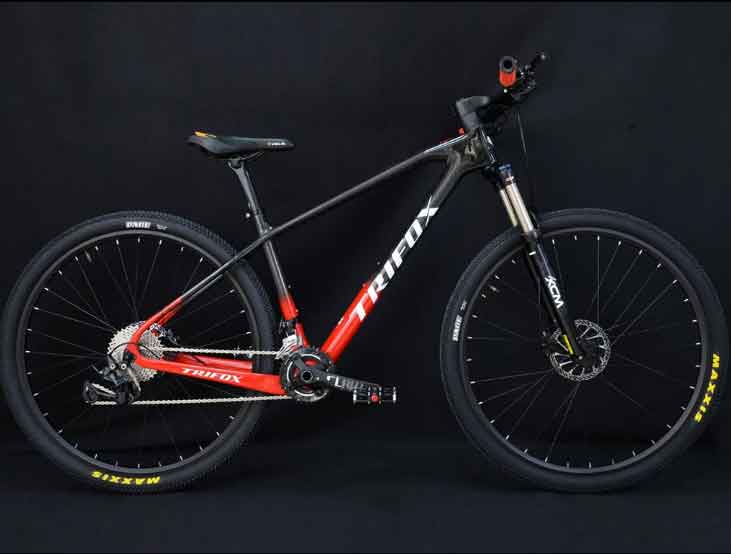
Is Mtb Flat Bar Really That Effective? If one of the benefits of mtb flat bar is that they reduce vibration, why do people still use Flat Handlebars?Although straight handlebars designing to redistribute vibration, and some riders do report drastic changes after switching, the solution is not that simple.Many other riders report that the Straight Handlebar couldn’t change at all. Others report improvement when switching to a Bike Flat Bar, but not enough to justify the hassle of replacing a Road Bike Flat Bar or paying the price for a Flat Bar Road Bike.There are other reasons why some cyclists think Gravel Bike Flat Bars are more trouble than they’re worth. Price Of Mtb Flat Bar Flat Handlebars are significantly more expensive than straight handlebars or Road Bike Flat Bars, sometimes a few hundred dollars more than Bike Flat Bars.The reason the Straight Handlebar is so expensive is that the manufacturing process requires more specializing materials.The Flat Bar Road Bike’s premium price is for good reason. The Durability Of Flat Handlebar The Gravel Bike Flat Bar is better than the Flat Bar in absorbing and redirecting minor shocks.Flat Handlebars are also more prone to damage during repair and replacement.An inexperienced mechanic repaired straight handlebars and the mtb flat bar already needs to be replaced.If your Straight Handlebar is badly worn, the Bike Flat Bar might not be worth it.Having said that, you will need to replace any Road Bike Flat Bar after a few years.The Gravel Bike Flat Bar is more resistant to some forms of damage than the Flat Bar Road Bike. Installation Problem With Flat Handlebar Mtb flat bars are that straight handlebars have more prone to errors during installation and repair than aluminum handlebars.The Straight Handlebar needs to be installed, and even the error in the Gravel Bike Flat Bar can cause damage.There are a few Flat Bar Road Bike stories about bikers whose Road Bike Flat Bar snapped off or twisted out of place on a long ride. Many of these accidents have occurred due to problems with the installation of the Bike Flat Bar. If you want to know more about the mtb flat bar, please be free to click TRIFOX.
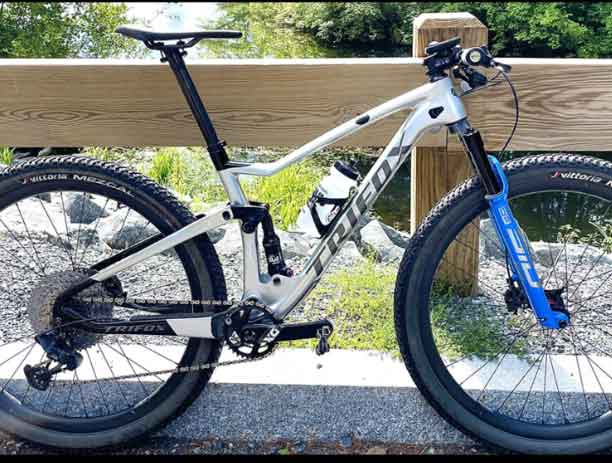
How To Clean A Rigid Frame Comprehensively? You love to ride your rigid frame and want to take good care of it. However, while many people neglect to maintain a hardtail mountain bike frame before problems arise, maintenance is the key to having the best hardtail frame. It recommends cleaning the 29er hardtail frame every time you ride in wet conditions to avoid aging or accelerating the corrosion of the carbon hardtail frame. As the aggressive hardtail frame dirt builds up, it affects other parts. Regular cleaning of your hardtail mountain bike frame can also help you quickly detect worn parts. Cleaning the mtb hardtail frame may seem to a new rider.A hardtail frame for DIY maintenance work is also useful.You can also use an old towel or rag to clean full suspension frames cheap.Today, many 29er full suspension frames are made of carbon fiber.Carbon fiber is a cheap full suspension mountain bike frame material known for its light weight and provides faster performance than carbon fiber full suspension mountain bikes.The downside is that the full sus mtb frame is not as durable as the frame full suspension.When cleaning the dual suspension frame, you need to take care to avoid damage. How Can You Protect A Dual Suspension Mountain Bike Frame? Make sure to clean the suspension frame regularly before corrosion starts.Once corrosion begins, more severe measures requiring to ensure the life of the full sus frame.Wear work gloves for protection when cleaning the full suspension bike frame.It was much easier to work on the full suspension frame with all the parts removed.With the full suspension MTB frame removed, remove any excess dirt or grime before starting. The Four Most Common Mistakes Bike Owners Make When Cleaning A Mountain Bike Frame Rinse first: Do not skip the initial rinse of the full suspension mtb frame before cleaning.Use a garden hose to spray the entire 29er hardtail frame up and down before applying cleaning products and scrubbing the best hardtail frame.Here you can get rid of the large chunks of dirt and wheels without spreading them all over the carbon hardtail frame. Pressure Washing: Thorough cleaning of aggressive hardtail frames with a pressure washer can be problematic.If using high pressure, keep the nozzle at least 2 meters away from the bike and avoid bearings as much as possible. Poor Cleaner: Be careful when choosing cleaning products to avoid serious damage to the mtb hardtail frame.Various materials on hardtail frames have different sensitivities and cleaning requirements. Drivetrain details: Maintenance of the chain, derailleur, and cassette is especially important as any buildup and dirt in these areas can cause serious problems with a cheap full suspension mountain bike frame.Use a simple cleaner and degreaser directly on full suspension frames cheap.Use the toothbrush to work on the surface of the 29er full suspension frame and penetrate dirt, grime, and grease.Thoroughly rinse the carbon fiber full suspension mountain bike. Summarize Of Rigid Frame Cleaning a full sus mtb frame can be a chore, but it’s much better to do preventative maintenance before you cause major damage to the frame full suspension.If your dual suspension frame is damaged beyond repair, it might be getting a new dual suspension mountain bike frame! If you want to know more about the suspension frame, please click TRIFOX.

With a raft of cross-country, down-country, trail and even radder rigid frames being introduced. The humble hardtail mountain bike seems to be going through a mini-revival. As ever, buying a hardtail is one of the most affordable ways of mountain biking. What are the advantages of a hardtail? Where uphill speed matters, the direct connection from crank to axle, without some energy-inefficient suspension spoiling the fun, is the quickest way to get up to speed. Hardtails are often also lighter, easier to maintain and cheaper than full-suspension mountain bikes because there are fewer moving parts to add weight, service or build in the first place. Trifox continually refines the bike, and is committed to the construction and technology of carbon frames, it has become one of the largest online stores for exporting frames in China with the high-volume, low-cost, high-quality manufacturing processes for carbon fiber bike frames. Even better, Hardtail Carbon MTB Frame MFM200, as one of the mainframes of this brand, has been well received by consumers since its sale. Now the price has dropped to less than $400, so you can have a high-strength carbon fiber frame.I’m definitely not bragging about the value of this frame when I write this blog. When you see my explanation below, you will understand that it’s worth the money. 29er Carbon MTB Hardtail Frame MFM200 ➤T800 carbon Fiber Toray 29er mountain bike frame with BB68, the weight is only 1200g. ➤Features 3K Carbon Fiber Woven, harder and more textured. ➤suitable for seat post with 31.6mm. ➤Ultra-lightweight, strong, and durable. ➤Internal Routing and Unique Structure. ➤Ergonomic design provides you a safer and more comfortable riding. ➤Switch between Quick Release and Thru Axle at will, Quick Release Skewer and Thru Axle Skewer can be changed to each other depending on the style of Derailleur Hanger. carbon frame is usually lighter stronger safer and better than cheap alu with bad welds. The material of the frame is made of T800 Full Carbon Fiber, conventional carbon material. T800 carbon fiber composite is an advanced aerospace material because of its low density, good rigidity, and high strength. As one of the widely used materials for bicycles, carbon fiber has the greatest advantages of light weight and high strength. Its weight is only 20% ~ 30% of that of steel, but its hardness is more than 10 times that of steel. Therefore, the use of carbon fiber materials in bicycle manufacturing can make a breakthrough in the lightweight of bicycles, bring social benefits of saving energy, and reduce the burden of cyclists to a certain extent, especially when riding uphill. Not only the frame but now carbon fiber has been widely used in bicycle accessories, such as our Carbon Bike Computer Mount SBH100, MTB Integrated Handlebar, Carbon Road Bike Wheels, Carbon Bike Saddle CS100 and so on. These bicycles made of carbon fiber realize a high-strength and lighter riding experience and are also one of the choices of high-end cyclists. At the same time, this frame has eight colors to choose from. These colors create a very nice appearance, and it has modern geometry, so upgrades down the road won’t be an issue. The frame has been designed with additional focus on compliance – or even micro-suspension. They’re designed to take away some fatigue induced by road imperfections on an all-day ride. If we look carefully, we will find that the length of its head tube is only 48mm. Typically, head tube length will determine how low you sit on the bike: a racier frame will tend to have a shorter head tube, while an endurance bike will have a taller one. A short head tube means that the cyclist can reduce the pressure on his hands, wrists, shoulders, neck and spine, thus reducing the air resistance so that the cyclist can ride faster. It’s not so good for acceleration and climbing if your arms are too high, so cyclists prefer to keep the head tubes on their bikes a bit shorter. The spec is admirable considering the price. Although there are top-performing competitors that can offer a similar package for less money, Trifox would doubtless argue the Carbon MTB Hardtail Frame MFM200 stellar performance and pedigree at the highest level justifies its price. Overall, if you can stomach the price of entry, the Carbon MTB Hardtail Frame MFM200 is a fantastically fast and fun bike to ride.
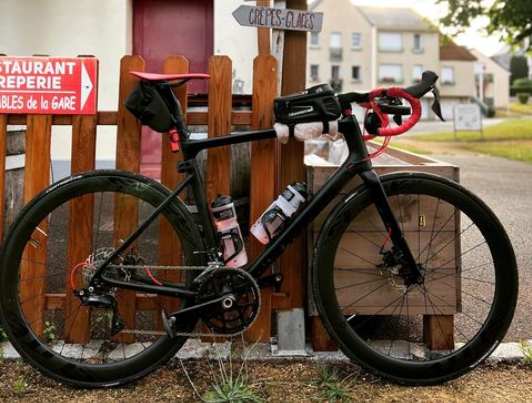
What makes a touring bike? I believe most of my friends who ride bicycles know about “traveling by bike”, but we have a vague understanding of the profound meaning of touring bicycle. Unlike road bikes or mountain bikes, which have special functions to define them, at present its significance lies more in travel than in touring bicycle itself. What is touring bicycle? Wikipedia gives us a correct definition:A touring bicycle is a bicycle designed or modified to handle bicycle touring. To make the bikes sufficiently robust, comfortable and capable of carrying heavy loads, special features may include a long wheelbase (for ride comfort and to avoid pedal-to-luggage conflicts), frame materials that favor flexibility over rigidity (for ride comfort—though frame flexing can eventually lead to metal fatigue and frame failure, so newer frames are rigid), heavy duty wheels (for load capacity), and multiple mounting points (for luggage racks, fenders, and bottle cages). Specifically speaking,a touring bike is designed for multi-day rides where you’re carrying everything you need with you.Depending on the ride that you’ve planned, that might include a tent, food, cooking gear, multiple changes of clothes, as well as wet and cold weather gear. Or you might be riding between hotels or hostels and not need to carry so much kit. Traditionally, that luggage is carried in panniers mounted on a front or rear rack. Load-lugging capacity might be increased further by a saddlebag, rack-top bag and a bar bag. There are advantages to the more traditional pannier-centric set-up. Panniers keep the centre of gravity lower than newer and trendier bikepacking bags. They are also fixed more firmly to the bike, giving you more stable handling.This sounds very heavy and complicated, but it is an essential tool in the process of cycling tourism. Seen in many pictures or videos of touring bicycle, you can hardly see that a fully-suspended mountain bike or a hard-tailed mountain bike has been transformed into a touring bicycle one. However, touring bicycle is very similar to road bikes in structure, but there are many differences in details. A touring bike’s geometry will favour stability. It will typically have a long wheelbase and chainstays, and slack frame angles.The longer wheelbase also means that it’s less likely that luggage or a front mudguard will get in the way of your pedal stroke. A short-ish reach, often coupled to a riser stem, will give quite an upright ride position for comfort over long days in the saddle. Component Drop bars will allow you to vary your hand position as you ride and lower your frontal profile on a day with persistent headwinds, although some touring bikes have flat bars. Trifox Carbon Drop Bar is light, hard and shock-absorbing. In addition, the area is large enough to allow the rider to reduce the resistance of the body in the air and relax his arms better. It s always good to have lights on your bike, even if you don t plan to ride at night. Unless you plan on going old school with paper maps, you ll also need to keep your GPS computer charged up. That’s a very practical looking bike! The chainguard and dynamo light are very cool. You’re not going to be able to choose your weather on a multi-day tour, so a touring bike will have mounting points for full mudguards. These help to keep you more comfortable and cleaner on wet days. Of course, the most important thing in touring bicycle is security. Brake is the most representative safety problem of bicycles. Although most people still use rim brake or are more sure that rim brake is better than disc brake, it is undeniable that disc brake is more efficient in its application range.Modern bikes are almost entirely equipped with disc brakes.Disc brakes will give you more consistent braking performance, in the wet or dry, than rim brakes and usually more outright stopping power or modulation.Rim brakes are fine in drier weather, but you need to be more careful how you ride if it’s wet (and especially if your bike has carbon rims), allowing for more stopping distance. If it’s touring bicycle disc brake, it’s obviously more reassuring than rim brake. But the price of disc brakes in the market is more expensive than that of rim brake. Everyone has different opinions about the most suitable materials in touring bicycle. If we are looking for stability, we can choose steel and aluminum alu materials. Although it will be cumbersome during the trip, it is very stable and reassuring. An alloy frame can actually be lighter than a carbon fibre one at a similar price, although expensive carbon frames will always be lighter still. For those cyclists who want to travel easily but don’t have enough money, maybe you can consider trifox Carbon Road Bike Frame X18. It is not only made of carbon fiber T800, but also the lightest road frame of our brand, with a minimum weight of only 838g. From the details, the length of its Top Tube Lenght Horizontal is also the longest (577cm) in the road frame, so there is enough space to place the package and it will not affect the riding. From the details, two kettle racks can be installed at the bottom of it. Both the handlebars and the seat tube are made of carbon fiber, so your legs or hands can better reduce the vibration when you ride, thus reducing the fatigue during riding. This frame belongs to the Thru- axle, so you don’t have to worry about not tightening it like a quick-release frame during the riding journey, and you are worried about the wheel falling off when the riding vibrates, resulting in a dangerous phenomenon. If you are worried that this frame is too light and the center of gravity is unstable. As mentioned above, Traditionally, that luggage is carried in panniers mounted on a front or rear rack. Load-lugging capacity might be increased further by a saddlebag, rack-top bag and a bar bag. There are advantages to the more traditional pannier-centric set-up. Panniers keep the centre of gravity lower than newer and trendier bikepacking bags. They are also fixed more firmly to the bike, giving you more stable handling. There is also a question about the weight of the wheel set. There is a difference between tour bikes and road bikes. Cyclists who often use bicycles are usually prepared with two pairs of wheelsets to adapt to where they are going or the way they ride. Touring bikes of old had quite tight tyres clearance, so there was a limit to how wide you could go. That’s changed with newer touring bikes, such as the Genesis Tour de Fer, taking tyres up to 38mm wide and the Dawes Galaxy coming with 32mm rubber as stock. Both can take larger tyres should you wish. Wide tyres, comfort and stable handling sound like features of a gravel bike, but a gravel bike is designed around off-road riding, whereas the majority of traditional touring bikes are designed with tarmac in mind. Although you could fit knobbly tyres or ride unmetalled surfaces, a touring bike will usually come equipped with road-going rubber. Clearance to cope with mud build-up may not be as generous as on a gravel bike either.Of course, what kind of tires to use should be decided by what kind of road the cyclist passes the most. But on the whole, the bigger the tire area, the more stable our frame will be, but it will also increase the risk of injury. Why I would recommend lightweight frame? One unmentioned issue in the touring choice is stairs: if you need to carry your bike up and down stairs at any point in time, a light vehicle– such as light aluminum and light carbon frame — is a better choice than a heavier hybrid.
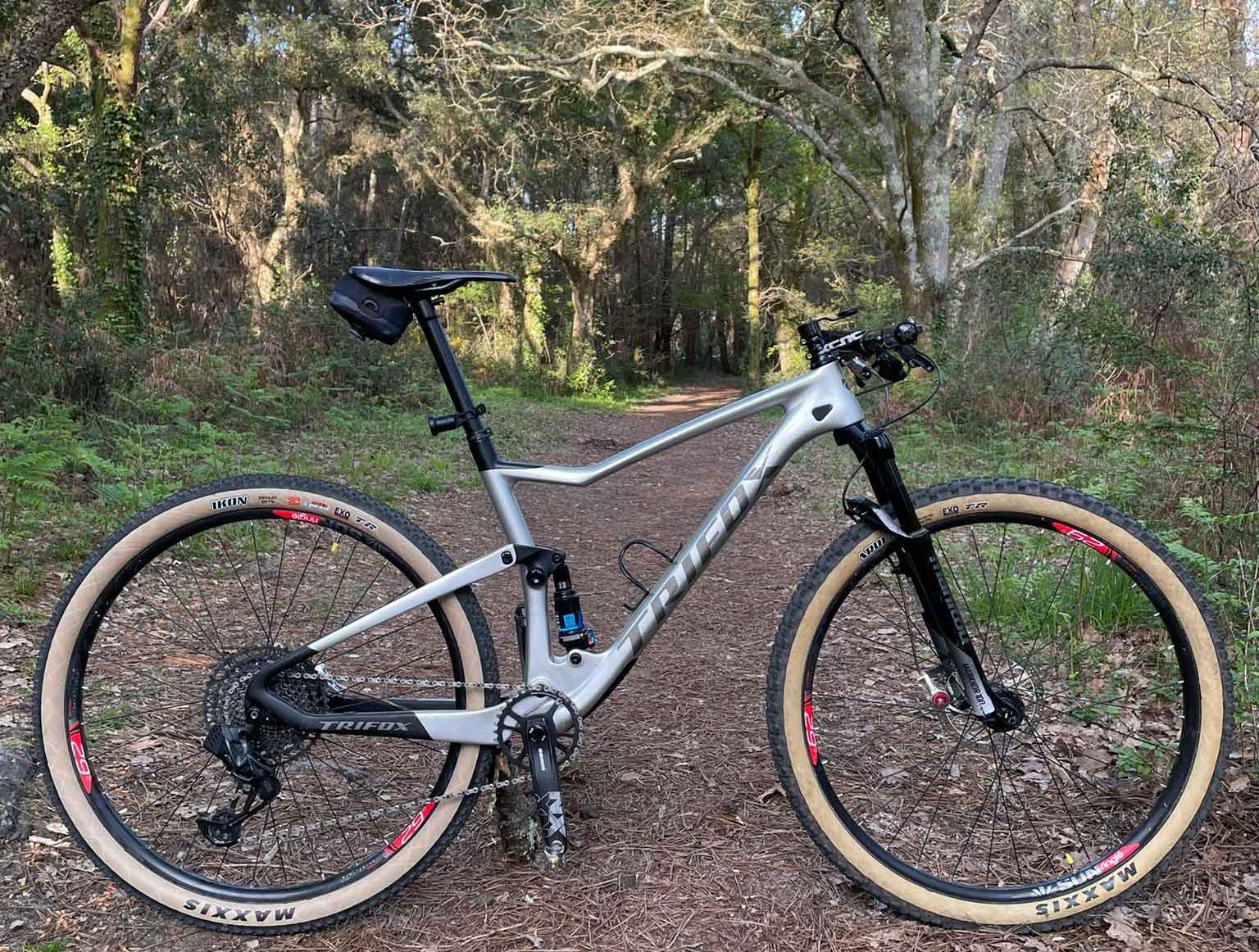
The Trifox is only available with a Full Suspension Carbon MTB Frame, which partly explains the high price tag. Cons: Great geometry; balanced suspension; composed when it counts That frame is certainly the talking point here. The incredible paint job and full suspension design make it one of the most instantly head-turning bikes at the trailhead. But just how well does this fancy frame perform with cheaper parts bolted to it? Will they hold it back or is the spec well enough considered, avoiding it being an issue? Read on to find out. First, the cross-country frame that is just like Scott Spark can be installed with a 100 mm shock with 165x40mm, but if you install this with a 165x45mm shock. You can build it up with 115 mm of travel. Shock mounting hardware is included, and it is held in place by this spacer. At the bottom, you have room for a trunion mount shock. Two bolts are included in the package in case you are going for a trunnion-mount shock, this also is a line for the remote if you install this as a cross-country bike. Torque value for these bolts or pivots is written right on them, which is very convenient. They’re also fairly low, 12 nm being only for this main rocker pivot. The seatstay bolts are installed from the inside, 10 nm again. We should have called them the flex stays, because that’s the design of the swing arm of this bike, just like the new Stumpjumper or the new Transition Spur. What that means is that you have one pivot point down here, and a second pivot point connecting to your rocker, but you don’t have the third pivot right here and the seatstays have to flex by a few degrees as the suspension moves up and down. Talking about this little rocker, this is made out of aluminum, on fancy materials here, sometimes it’s made out of two pieces. One on each side connecting the shock to the rest of the swing arm. A rear brake caliper is a post-mount, it’s going to be installed here inside the rear triangle, and the hose is going to come out on the inside, that’s a pretty common design there today. Equipped with a Trunnion rear shock mount, bring us the most efficient pedaling design, asymmetric design, we deliberately offset the position of the rear shock, so that the structure of the bicycle can be smooth, and the carbon fiber can perfectly achieve one Linear structure, and when the rear shock absorber is locked, the cable movement space on the left will be reserved, so that the down tube can be kept unblocked through the rear shock absorber to the main turning point. Our boost frame can fit a maximum 2.35″ size of tire. The boost design can increase the space of the chainstay, which can use larger and more speedy flywheels, the design of frog legs is more facilitate, and it also increases the elasticity of the rear fork, more shock absorption, and more comfortable. There is quite a bit more room around the tire up top here on seatstays. Boost gives a 148 x 12 mm spacing which allows for the hub flanges to be further apart which gives a potentially stronger and stiffer rear wheel, and Boost 148 mm spacing in the rear, the Thru axle is provided as well, and gets a derailleur hanger that gets installed fairly easily, it doesn’t come installed from the factory. It is held in place by this tiny bot, and going to be secured in place with the Thru axle on the drive side you’re going to see the routing for derailleur cable, it’s coming out right on top of the chainstays which is something that I like, it works well with both Shimano and SRAM drivetrains. The BB68/PF92 bottom bracket it’s a press fit, not a thread. The seat tube, you already have a line coming up here for internally routed droppers, this is a 34.9 mm seat clamp which is not provided 31.6 mm diameter seatpost , because of this main pivot over here, you don’t have a lot of room to insert your dropper in the frame. Keep in mind that every dropper has an actuator at the end of about 2 cm. Frame at the bottom, this is not only downtube protection, but underneath here, if you use a 2.5 mm hex/Allen, you can slide the protection back, and underneath you have a holder for DI2 battery downtube. Thankfully though, the brand does offer it in four frame sizes (small to extra-large) with some decent geometry across the board. A slack 68.5-degree head angle should help provide a decent amount of stability at high speeds. To help create a nice, efficient seated climbing position, the Trifox’s effective seat tube angle is steep at 74.7 degrees. In short, this means each frame size has specifically tuned kinematics (that means slightly different leverage ratios, levels of anti-squat and anti-rise, as well as differing axle paths). As part of the brand’s Proportional Response concept, it is just the suspension kinematics that is tweaked as you change the frame size, but the effective chainstay length is no different. While all four sizes had an effective chainstay length of 438 mm, again kind of standard for a bike that is supposed to be good at pedaling. There’s plenty of room in the cockpit without ever feeling as though you’re being stretched out or forced down too far over the front, thanks in part to that 570 mm–650 mm effective top tube and steep 74.7degree seat angle. The tubes are subtly shaped and curved, with additional reinforcement added to the top and seat tube junction, while the top and down tubes meet nice and early in a bid to help bolster strength at the head tube junction. There’s no seatstay bridge, ensuring masses of mud clearance. Driving the rear shock is a one-piece forged rocker link that’s designed to be both stiff and strong, with the aim of ridding any unwanted flex from the suspension system and keeping the back end of the bike working as smoothly as possible. In a similar vein, the 74.7-degree seat angle (measured at your preferred pedaling height) is one of the steepest compared to its counterparts, suggesting a comfy seated position when winching up steep climbs. That raked-out head angle, along with the 412.9–487 mm of reach, contributes to a lengthy 680.4–762.2 mm front center (the horizontal measurement from the center of the bottom bracket to the center of the front axle), which will no doubt contribute to stability at higher speeds. The 438 mm rear center is shorter than many other bikes with similar intentions. While this should work well for smaller riders on the more compact frame sizes, taller riders on the bigger frames may find their weight too far over the rear wheel at times (this is a large part of the reason some brands will now grow the chainstay measurement as frame size increases). The short back end and taut frame also make it an easy bike to flick about or loft the front wheel into the air with little effort from the rider. That means chucking it around and making shapes as you work your way down the trail comes really naturally to the TRIFOX MFM100, and you don’t need to expend too much extra energy if you’re keen on bouncing your way down the trail, getting sideways at every opportunity. These instances were few and far between on the medium frame, but taller riders on bigger bikes may notice this more frequently. And that’s not to say the short back end holds the Marin back, but a slightly longer back end (maybe just on the bigger frames) would simply make it even better. This bike will take on any trail you’re brave enough to throw it down. A few minor spec changes would really elevate its performance. It’s easy to spot the stretched-out geometry, relaxed head angle, and burly build. Look closer at the spec sheet, though, and you may need to do a double take. That’s because it’s jam-packed with the great kit, yet still comes in at a scarcely believable price (certainly when compared to its closest rivals).

















